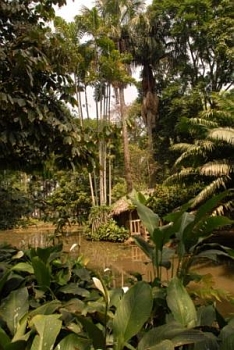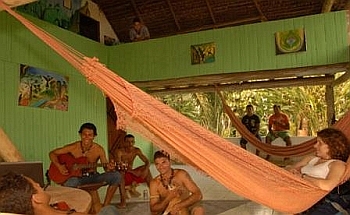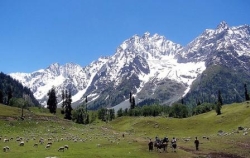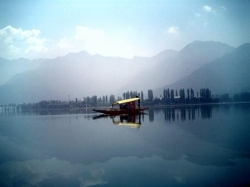In advance of TonyÂ’s trip to the interior of Brazil later this year, I have dug up the account of his previous adventure, with Mm Mitterand and the Ashaninka. Globetrotters Club members recall Tony presenting an abridged version, but for those who wish to know moreÂ…
The Ant
The small plane lifted of the tarmac, climbed into the sky, banked away from Rio Branco by the border of Brazil and Peru; and at last we were up, up and away on the last part of our journey to visit the Ashaninka near the small town of Marechal Thaumaturgo.
 I saw our future and the future was green, not just the sea of green we were flying low over with the occasional break in that verdant mass below, revealing a river with its golden banks meandering through the luxuriant forest. It has been sometime since I had been with a group of VIPs but now instead of doing a sword dance with a Saudi Prince I was in a small twin engined plane flying over the rich green rainforest of the State of Acre in Brazil accompanying Mm Danielle Mitterrand, the widow of a past French President, The Ministra do Meio Ambiente from Brasilia, the Governor of Acre and the usual body guard, TV cameraman etc. which follow VIPs. Last, but not least of all was Joao Fortes the leader of our small group and passionate helper of the Indians for more than twenty years, Cristina MendonÃĤa (expert on carbon credits), Maria Alice, whose expertise was to help the Indians make the right craft goods that would sell in the outside world.
I saw our future and the future was green, not just the sea of green we were flying low over with the occasional break in that verdant mass below, revealing a river with its golden banks meandering through the luxuriant forest. It has been sometime since I had been with a group of VIPs but now instead of doing a sword dance with a Saudi Prince I was in a small twin engined plane flying over the rich green rainforest of the State of Acre in Brazil accompanying Mm Danielle Mitterrand, the widow of a past French President, The Ministra do Meio Ambiente from Brasilia, the Governor of Acre and the usual body guard, TV cameraman etc. which follow VIPs. Last, but not least of all was Joao Fortes the leader of our small group and passionate helper of the Indians for more than twenty years, Cristina MendonÃĤa (expert on carbon credits), Maria Alice, whose expertise was to help the Indians make the right craft goods that would sell in the outside world.
Why was I there? I had been invited by Joao Fortes to write and take pictures of the Ashaninka as I and Adam Baines had twelve years ago about the Yawanawa people. This time instead of going up the river Juria, I was going to take the right fork up the river Amônia towards the border of Peru. Before that though I was to accompany the French delegation and record Mm Mitterrand’s meeting and signing of an agreement between France and the Ashaninka and the State of Acre.
The village greeted the very pleasant widow representing France and it seems in no time at all we were all exchanging views and the Indians were explaining how they had made their people live a sustainable way of life in the rain forest and now wanted to show the rest of the State of Acre how this could be done. This charming lady was told how they had no cattle on their land but planted thousands of trees each year and bees that did not sting but produced a honey, so good, that the gods would come down from the heavens to taste it. They had many different fruits, many types of potatoes, also a great knowledge of over two thousand medicines that the forest provided. They also wanted to publicise the fact that people were invading from Peru, with ‘PistoleirosÂ’, with large machines, that ripped out the trees and then pulled them back to Peru and then said they had been grown under licence there. Also the chemicals that these invaders were using have started to change the taste of the fish in the Rio Amônia. The Ashaninka have started to petition other nations as well as their own government to do something about this problem. The Brazilians have now put in satellite phones in the border villages, so that State forces can be called up to help in case of invasion by these foreign companies.
After Mm Mitterrand had collected some honey, planted a tree, taken a short trip up river, with body guards, TV Cameraman and the rest of the entourage – She was whisked off to Rio Branco to sign documents with all the group, leaving Cristina of carbon credits and myself back at the Ashaninka College.
Benki was a charming remarkable man and from the age of thirteen he had taught himself all about the forest, its over two thousand medicines and how to make the tribe self sufficient and was now the recognisable face of the tribe on TV or in the political circles of Brasilia. His paintings are shown in Rio de Janeiro, his music sells on CD and women fall at his feet – Intelligent, charismatic, good looking and IÂ’m glad to say he is a good friend of mine – I will say, that I would surely like some of his magic to rub off on me! Benki playfully said to me “Tony my friend, you are lucky you were not born in my village – Nobody wears glasses because no one in the tribe is short sighted. No woman would marry me because I would not be able to hunt fish and look after a family”. Survival of the fittest and I certainly wasnÂ’t the fittest either in the rain forests or in cities with their high forests of concrete reaching for the sky. The Ashaninka are very fit, healthy and the only person who wore glasses was one lady in her seventies. The Uruku, the paint on their faces, gives them a very good skin complexion and also acts as a mosquito repellent. Aveda, the makeup company, use it in their lipsticks etc. And buy it from the ‘Yawanawa TribeÂ’.
Cristina and I spent an interesting night at BenkiÂ’s house on the other side of river in Marechal T, built to show the locals that a house can make its small section self sustainable and it certainly was – He reared chickens, grew fruit and vegetables and needed very little to be bought in to his home. He played his guitar, sang and listened to Cristina explaining the ins and outs of Carbon Credits as she was leaving next day to go back to her consultancy in Rio de Janeiro. Sunday, Benki and I hit the beach where the rest of the School and the residents of the small town pretended they lived on the coast and behaved as if they lived by the Atlantic instead of thousands of miles inland – We downed a few cold ones and planned the next part of the trip, basically turning right up the River Amônia and going up river for a few hours until we reached the Ashaninka village.
 Picture by Tony Annis : Benki and friends at his home with the Ashaninkas
Picture by Tony Annis : Benki and friends at his home with the Ashaninkas
We reached the village and of course, right in the middle of it was a football pitch – The Ashaninkas are Indians but also Brazilian and all Brazilians love football. We had broken our journey to take some pictures of his family and watch a local tournament and unfortunately watch the tribe lose even though Benki came off the bench to play centre half and shore up the defence. Benki told me, “I am growing ‘The greenest little stadium in the world’ I have cleared the ground and started planting palms to cover the thousand spectators and then I will try to weave in flowers the names of famous European teams, such as Chelsea and Juventus and probably a French one as they are helping us now”.
Benki showed me round the village, the tree plantations, the pond where the turtles were reared, and the ladies making their craft beads, as well as one of them making their homemade beer for a village party. We were going further up river to a waterfall and camping for two or three days but as luck would have it we broke our propeller and one of BenkiÂ’s friends had to fix it by carving a propeller out of wood and all without the help of anything other than a knife and a stone used as a hammer. This coming July I hope to return and complete the journey to the waterfall with a few good friends of mine.
We headed down river back to the College of the Forest, via Cruzeiro du Sul (For Benki to pick up his e-mails). Finally, Rio de Janeiro for Benki and other Brazilian personalities to plant trees live on TV and for Benki do a brilliant live two minute piece to camera and as one of the Politicians said, “If I could only speak as well as that and to time, I would be Governor in the State of Rio by now, instead of being a local Deputy”. All this on my last day and before long the big plane lifted of the tarmac, climbed into the sky, banked away from Rio de Janeiro by the border of Brazil and once again I was up, up and away.

 I saw our future and the future was green, not just the sea of green we were flying low over with the occasional break in that verdant mass below, revealing a river with its golden banks meandering through the luxuriant forest. It has been sometime since I had been with a group of VIPs but now instead of doing a sword dance with a Saudi Prince I was in a small twin engined plane flying over the rich green rainforest of the State of Acre in Brazil accompanying Mm Danielle Mitterrand, the widow of a past French President, The Ministra do Meio Ambiente from Brasilia, the Governor of Acre and the usual body guard, TV cameraman etc. which follow VIPs. Last, but not least of all was Joao Fortes the leader of our small group and passionate helper of the Indians for more than twenty years, Cristina MendonÃĤa (expert on carbon credits), Maria Alice, whose expertise was to help the Indians make the right craft goods that would sell in the outside world.
I saw our future and the future was green, not just the sea of green we were flying low over with the occasional break in that verdant mass below, revealing a river with its golden banks meandering through the luxuriant forest. It has been sometime since I had been with a group of VIPs but now instead of doing a sword dance with a Saudi Prince I was in a small twin engined plane flying over the rich green rainforest of the State of Acre in Brazil accompanying Mm Danielle Mitterrand, the widow of a past French President, The Ministra do Meio Ambiente from Brasilia, the Governor of Acre and the usual body guard, TV cameraman etc. which follow VIPs. Last, but not least of all was Joao Fortes the leader of our small group and passionate helper of the Indians for more than twenty years, Cristina MendonÃĤa (expert on carbon credits), Maria Alice, whose expertise was to help the Indians make the right craft goods that would sell in the outside world. Picture by Tony Annis : Benki and friends at his home with the Ashaninkas
Picture by Tony Annis : Benki and friends at his home with the Ashaninkas
